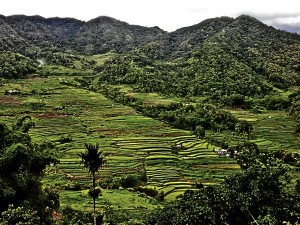
Before visiting Banaue last year, I had never heard of Mayoyao, Hungduan, Batad or Kiangan. To me, they were all just part of the Banaue rice terraces.
But Banaue is only one municipality in Ifugao province, which is filled with rice terraces.
Eleven in the evening was the call time for the members of the Canon Advocacy Team (A-Team) that was traveling to Ifugao. The A-Team is composed of volunteer photographers who use their skills to help various initiatives of Canon Philippines and brand ambassador John Chua.
Our objective was to document the five World Heritage Sites in the Province of Ifugao, to help shed light on issues affecting them, through a photo exhibit in Ifugao, and eventually a roving exhibit in SM Malls.
The trip north was pretty uneventful on our two Mistubishi Stradas, as traveling at night made the drive a lot easier. The road to Banaue is paved all the way, except along Dalton Pass, where the road is undergoing construction. That delayed our trip for over an hour.
We arrived in Lagawe, the capital of Ifugao, around 7 a.m. for a short breakfast meeting with Ifugao Gov. Eugene Balitang and his staff to plan our five-day expedition.
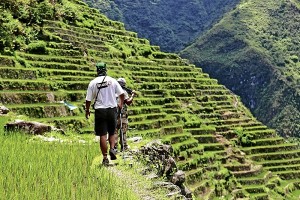
After breakfast, we divided into two groups. John and his group headed toward the rice terraces of Kiangan, while we set out for Hungduan, a two- and-a-half-hour drive from where we were. With cameras strapped and tripods tucked away, we were all excited for this first day of the expedition.
Spider Web terraces
A 4×4 vehicle is definitely a must in Ifugao, as large portions of the road remain unpaved. Our vehicle and driver, Michael, were up to the challenge.
In Hungduan, representatives of the municipal office welcomed us. When they said multiple sites, I did not realize that the Unesco World Heritage site in Hungduan covered several barangays.
The first stop was the Spider Web terraces of Bacung, a short 20 minutes away, so called because when viewed from the air, the terraces converge in a weblike shape. Unfortunately, many of the original terraces have long been abandoned or are now overgrown, so it was hard to see the pattern from our vantage point on the ground.
Webber, our guide, told us there is a move to restore the original terraces, but funding and commitment are sorely lacking.
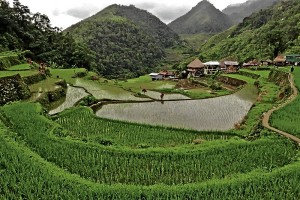
After lunch we proceeded to Hapao, a barangay almost on the border between Hungduan and Banaue. From the road we could see the entire area, with the terraces spread out over a valley in a gradual incline. While the terraces are not as steep as others, we still had to walk down a flight of steps to reach them. I stopped counting at 100.
Shooting in Hapao gave us our first chance to shoot from inside one of the terraces, as opposed to above it. We were after the lines and the play of light so we scrambled across the rice fields to capture as much as we could before the light ran out.
Above, the clouds began to form, which gave our pictures a more dramatic feel, but unfortunately that also meant the possibility of getting drenched. Just as I was packing up and getting ready to make my way back, it began to rain.
The short 10-minute walk became 20 as we all tried not to slip on the steps. I noticed that in Ifugao, when it rains it really rains. As we found out later, we actually had it easy compared to the other group. Several members slipped and fell throughout the afternoon downpour.
Seeing our home during this expedition was a comforting sight, especially after a long day of traveling. While there are several accommodations in Banaue, many of them are inns. Banaue Hotel is the only accommodation offering hotel services.
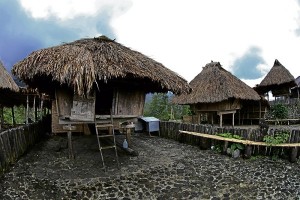
Nothing really beats a hot shower and a comfortable bed after a long day traveling. After a grand buffet dinner in the hotel’s main dining hall, we hit the sack, knowing that the next day would present new challenges.
Your next meal
Day two started early, as the trip to Mayoyao was more than two hours. After a quick breakfast, our convoy left under sunny skies and cool winds. When in Banaue, it is always a good idea to eat your fill before leaving in the morning—you don’t know when and where you would have your next meal. Packing fruit and energy bars is also a good idea.
The road we took gave us a great view of the different terraces between Banaue and Mayoyao, each with its own characteristics.
Our first stop was the village of Bangaan, another Unesco World Heritage site. The main road offers a top view of the sprawling terraces. We did not visit the actual village. Bangaan is just a short 25-minute walk down. The village is small, with a little central area the villagers use for their rituals.
The rice terraces of Ducligan, where the movie “Mumbaki” was filmed, was another interesting site along the way. We looked down on the valley and saw green terraces on the edge of a river, the pattern disturbed only by a small enclave of houses.
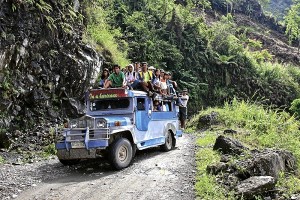
We reached Mayoyao town proper around 10:30 a.m. and headed down toward the rice fields of central Mayoyao. We were told that there were also waterfalls and ancient burial grounds in the area.
Once I saw the grandeur of the rice terraces, all the aches and pains were forgotten. Standing in the middle of a field of yellow and green, I could feel the sight’s calming effect on my soul.
It was lunchtime when we got to our next stop, a viewpoint overlooking the entire Mayoyao rice terraces. Adobo and veggies were served but the view was too amazing to resist, so a little multitasking was called for as we tried to capture as much as we could without getting food on our gear.
The rain caught up with us again, but fortunately we were already in the car when it hit. Nevertheless, it was still a wet and bumpy ride back to Banaue Hotel.
Return to Batad
My last visit to Batad was in February, and I was excited to see how much work had been done by volunteers who have been going there to help out in the last three months. The next day, we packed ourselves into one vehicle and headed to the Batad saddle, a short hour-and-a-half drive over mostly rough roads.
I dressed for rain, but to my dismay, the sun was up when we reached the Saddle point, and we trekked 40 minutes down to Batad viewpoint. As I neared the registration booth, the familiar sight of the amphitheater-like terraces towering above us came into view. Over at the top left corner I could see the path to the village of Cambulo, where I was planning to spend my time on this short visit.
The group parted ways at Simon’s Inn. John and his group headed toward ground zero to meet up with some volunteers, Rod Sollesta and Earl Choa headed for Tappiyah Falls, and Pet Salvador and I trekked high above the terraces just below the tree line toward our desired destination.
We wanted to be inside the terraces and still show their grandeur, so we chose a vantage point high on the terrace, on the opposite side from where we came. The view was amazing as we walked another 45 minutes above the terrace. Looking down, we could see the village sitting in a sea of green, as most of the terraces were ready for harvest.
We could also see the impact of the damaged portions and the many volunteers working to get things back to working order. It was a humbling experience sitting on the edge of one of the walls and realizing how small we were in the grand scheme of things.
Trekking back and forth was like a balancing act as we walked on the terrace walls, which could not have been wider than one foot in some places. We were just in time for lunch when we got back to Simon’s Inn, and as usual my favorite corned beef, garlic and tomato pizza was waiting for me, just enough to give me energy for the trip back.
Heading back to the Saddle and eventually Banaue was almost a blur, as we were inundated by sudden rainfall. Thank God for trekking poles and large rain ponchos.
In the hotel, we treated ourselves to a nice hot meal as a reward for the day. After a short celebration, and our gear and equipment all prepared for our last day, we all went to bed content in the knowledge that we were almost done with what we had set out to do.
Our trip home
We started the next day a little slower as we packed up and prepared for our trip home. We had one last stop on the agenda as we made one short detour back to Kiangan.
While Kiangan is best known as the place where Japanese General Yamashita surrendered during World War II, it is also the location of the rice terraces of Nagacadan, the last of the World Heritage Sites on the list.
John’s group visited the place on the first day, but since they spent a lot of time falling and picking each other up, we wanted to go back to make sure we got the images we wanted. Unfortunately, the weather was not cooperating, so we waited for a break to take some last shots and complete our tour of the five World Heritage Sites in the Province of Ifugao.
While the expedition was a trip to document the rice terraces, it also became a roadtrip for five guys with similar interests and passions, driven by an objective to do something worthwhile—to help bring back the very spirit that built the terraces.
We left Kiangan around 3:30 p.m. and managed to reach Makati by 11:30 p.m. that day. Driving back during the day, when you could see the road, is a different experience, but that’s another story.











































